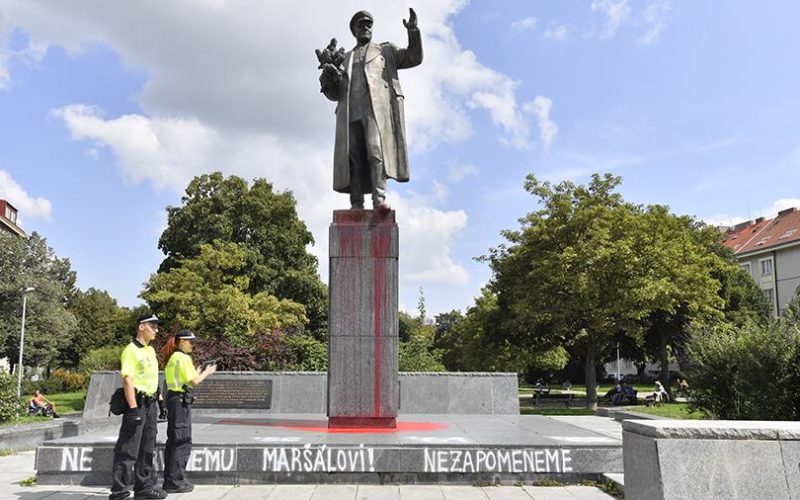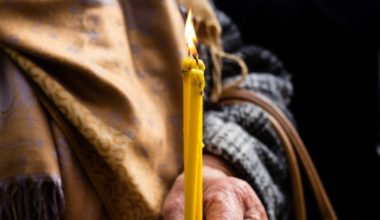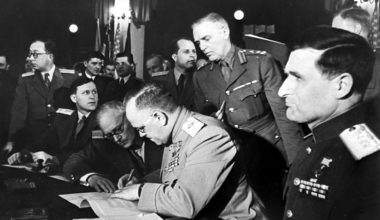On April 3, 2020, Prague 6 district authorities dismantled the monument to Soviet Marshal Ivan Konev who liberated the city during WWII and saved it from being destroyed by Nazis. Ondřej Kolář, head of the district, made fun of the demolition in his comment, “He was not wearing a mask. Everyone must obey the rules. One only goes out wearing a mask or other object covering mouth and nose.” The demolition of the monument arose anger in Russia. However, the act itself was preceded by years’ long anti-Konev efforts by the Czech political right that often remain hidden from the public.
The Prague Offensive was the last major military action of the Red Army in the Great Patriotic War. From May 6 to May 11, combined efforts by the 1st, the 2nd and the 4th Ukrainian Fronts defeated the German Army Group Center and part of Army Group South, liberated Czechoslovakia and its capital, Prague. After 35 years on May 9, 1980, a monument to Marshal Ivan Konev, the commander of the 1st Ukrainian Front, was inaugurated in Prague. At that time, a street in Prague was named after Ivan Konev, in addition to a memorial plate set on the Prague city hall established back in 1946, reading in Czech and Russian, “On May 9, 1945, the troops of the 1st Ukrainian Front of the Red Army commanded by Hero of the Soviet Union Marshal Ivan Stepanovich Konev conducted a vehement attack to liberate Prague that had risen against German occupiers. In a gesture of gratitude, Prague elected Marshal Konev a citizen of honour.”
In 2017, the memorial plate was dismantled during reconstruction works. The Russian embassy in the Czech Republic had appealed to Prague authorities, in its multiple special statements, to restrain from short-sighted political action and return the plate. Speaker of the Czech Parliament Radek Vondráček asked Prague mayor Zdeněk Hřib to bring the memorial plate back where it used to be. “I wish the complicated relations with Russian Federation would not be burdened by yet another issue which is symbolic for both countries,” the speaker wrote. However, the Prague mayor refused to return the plate, claiming that the text presents history in an inaccurate way. Later, the city authorities said the plate would join the collection of the City of Prague Museum.
In Žižkov cadastral district (Prague 3), some right activists demanded that Konev Street had to change its name, based on the assertion that the Soviet Marshal took part in the suppression of the 1956 Hungarian uprising and coordinated building of the Berlin Wall in 1961. They also accused Konev of supporting “information intelligence before the invasion of Warsaw Pact troops in Czechoslovakia” in 1968, despite the fact that Konev, due to his age, left had all commanding posts in the Soviet Army as early as in April of 1963. However, to rename a street turned to be more difficult than to remove the memorial plate. Many local residents did not like the idea. Moreover, for thousands of residents and hundreds of small and medium company employees, renaming would mean the need to change passports, papers, bank accounts, insurance policies, etc. Žižkov district authorities said that the renaming decision had to made “as a result of a consensus between the public and historians” and put off the discussion for long.
The residents of Prague 6, the district where the monument have been since 1980, did not demonstrated any disregard to it in the past either. As in Prague 3, the problem was rather overblown by right activists receiving support from this district’s authorities. Since Ondřej Kolář, member of the Czech conservative TOP 09 party, took up the post of the district’s head, barbaric acts against the monument became regular. It is worth noting that the political rhetoric of TOP 09 portrays Russia as the worst strategic enemy and a destabilizing factor for the Czech republic. The 2010 elections were the party’s biggest success, with 16,7 percent of votes. In 2017,they barely cleared the 5 percent barrier.
The efforts taken by this undeclared coalition of politicians and activists were a success on September 12, 2019 when members of the Prague 6 district council decided to move the monument to Marshal Konev. They decided to send the statue to a new Museum of 20th Century Memory (Muzeum paměti XX. století), which was yet to be created, replacing it with a new memorial celebrating the liberation of Prague from Nazi troops. The latter, as the district council said earlier in its ruling, will be dedicated not only to Red Army soldiers, but also “Soviet-born people who fled from Stalin’s terror” (meaning the Vlasov army).
This decision, though welcomed by right activists rallying in front of the district council, dramatically divided the Czech public opinion. Several weeks before that the idea to preserve the monument received public support from Czech president Miloš Zeman, whereas Jan Hamáček, the first deputy prime minister, suggested that a referendum should be held among Praguers on the issue, adding that he himself would like to see the monument untouched. Czech communists also stood up to defend the monument. The Communist Party of Bohemia and Moravia strongly objected the move and asked the government to keep the monument where it was.
Multiple protests made Prague 6 district authorities retreat from their plans. Only in the spring of 2020 did the demolition took place, as the coronavirus quarantine in the city made all protests by monument supporters impossible.


